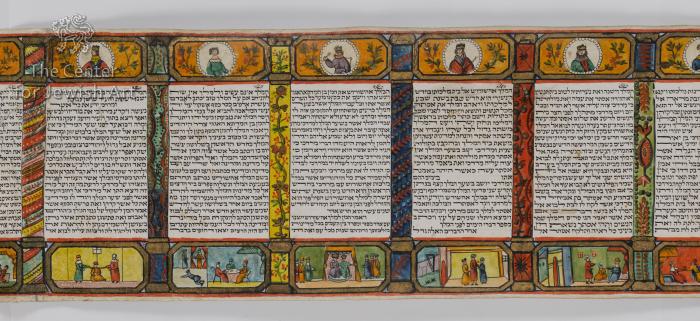Img. ID: 328808

Frame 5: In the upper margin, a bust of a crowned man is depicted; he can be one of the princes of Media and Persia listed in Es. 1:14. In the lower margin, three figures are shown - the king, a man (Mordecai?) who stands in front of him, and Esther who is kneeling. The scene is difficult for an unambiguous interpretation. It can be the moment when Haman's property is given to Esther and Mordecai (Es. 8:1), the moment when Esther pleads the king to annul the decree (Es. 8:3), or the moment when the king speaks with Esther and Mordecai (Es. 8:7-8).
Frame 6: In the upper margin, a bust of a crowned man is depicted; he can be one of the princes of Media and Persia listed in Es. 1:14. In the lower margin, on the right and in the center, Haman talks to his wife, Zeresh, and/or his friends (Es. 5:14). On the left, the gallows Haman prepared for Mordecai is shown (Es. 5:14).
Frame 7: In the upper margin, a bust of a crowned man is depicted; he can be one of the princes of Media and Persia listed in Es. 1:14. In the lower margin, the royal couple accompanied by courtiers; it is difficult to determine if any particular event is represented here.
Frame 8: In the upper margin, a bust of a young woman is depicted. In the lower margin, on the right and in the center, Esther's second banquet with the king and Haman is depicted (Es. 7:1). On the left, Ahasuerus returns from the palace gardens while Haman is begging Esther for mercy (Es. 7:8).
Frame 9: In the upper margin, a bust of a crowned man is depicted; he can be one of the princes of Media and Persia listed in Es. 1:14. In the lower margin, Queen Vashti is portrayed while she is strangled by two women standing on either side of her. During the execution, she kneels with her hands crossed on the chest and the crown lies on the floor. The Book of Esther does not mention the fate of Vashti after her refusal of the king's order and the source for this representation remains unknown. The same theme, although illustrated in a slightly different way, can be found in the Esther scrolls "with portrait medallions" and "with landscapes" and in the scrolls designed by Marcus Donath (Mordecai ben Jozl Sofer) of Nitra (see their descriptions in the Index).
O | Ornamentation: | Foliate and floral ornaments
E | Esther, Book of (following the order of the story) | Esther at Ahasuerus' feet, pleading he annuls Haman's decree (Es. 8:3)
E | Esther, Book of (following the order of the story) | Gallows built for Mordecai (Es. 5:14)
E | Esther, Book of (following the order of the story) | Haman talks to his wife, Zeresh, and friends (Es. 5:14)
E | Esther, Book of (following the order of the story) | *Esther's Story Characters (depicted not in narrative scenes): | Ahasuerus and Esther, enthroned
E | Esther, Book of (following the order of the story) | Esther's second banquet (Es. 7:1)
E | Esther, Book of (following the order of the story) | Ahasuerus returns from the palace garden (Es. 7:8)
E | Esther, Book of (following the order of the story) | Haman begging for his life (Es. 7:8)
E | Esther, Book of (following the order of the story) | Execution of Vashti - strangulation
E | Esther, Book of (following the order of the story) | Mordecai before Ahasuerus (Es. 8:1)
E | Esther, Book of (following the order of the story) | Ahasuerus speaks to Esther and Mordecai (Es. 8:7-8)
| (?)
The scroll consists of 3 membranes containing 22 text columns with 22 lines, except for col. 19 with 11 lines divided into two parts.
Every letter ל in the words המלך occurring in the first lines of the text columns is decorated with elaborate tagim.
The text includes an enlarged ח (Es. 1:6) that is formed of two parts joined with a roof and its legs end with serifs. In the text, the enlarged letter ת (Es. 9:29) is included too. In addition, traditional enlarged and diminished letters are in col. 19; they are also decorated with elaborated tagim and in the case of two of the letters, additional strokes are drawn below them.
In the first text panel are inscribed all three benedictions preceded by an adequate Hebrew headline ברכות מגלה. Whereas the last panel contains the final benediction followed by a shortened version of ארור המן Arur Haman.
In general, the ruling is slightly visible.
The parchment is bright; both sides of the sheets are very similar so it is difficult to distinguish between the flesh and hair side of a sheet.
The membranes are glued which was relatively rare for Esther scrolls.
In the institutional and private collections, other scrolls decorated with a similar pattern are stored.



